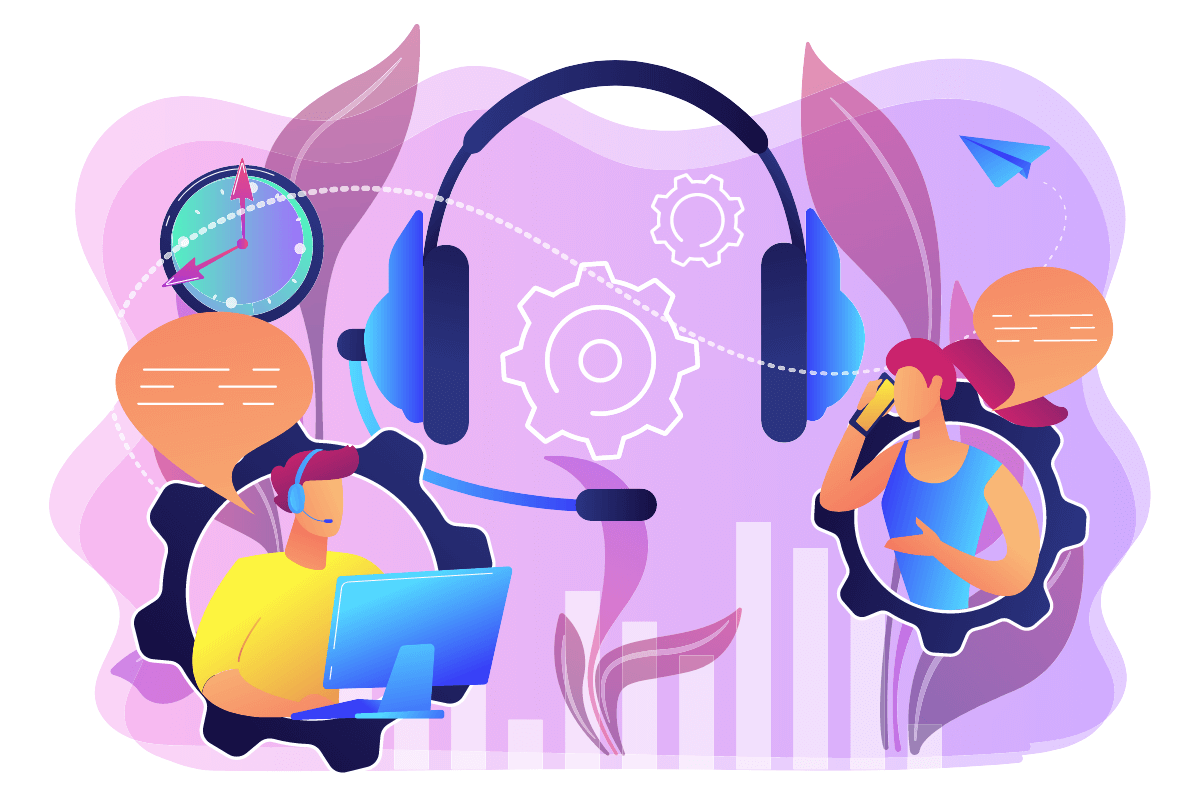Table of Contents
Suppose a customer encounters an issue with your company’s product or service. In such situations, they reach out to your customer service department with certain expectations. They hope for two things from your team: a positive interaction where they feel their concerns are acknowledged and resolutions to their product or service issues.
A favorable customer service experience not only addresses their immediate needs but also fosters loyalty to your organization, even if their specific problem isn’t entirely resolved. It’s crucial for every member of your organization to collaborate in delivering exceptional personal interactions to your customers.
In this article, we will delve into the realm of customer service experiences. Keep reading to learn more.
What Is Customer Support Experience?
Customer support experience is the quality of a customer’s encounter with a company’s support team. It is also how a customer feels or thinks while and after interacting with a customer support specialist to seek assistance.
The support team makes sure that it resolves or addresses customer problems or issues successfully and that it exceeds client expectations. Providing a consistently excellent customer experience improves the brand image, helps a company stand out from competitors, and opens up an opportunity for repeat purchases.
In fact, a study by New York-based software developer Stella Connect shows that 80% of customers feel emotionally connected to a brand when its customer support team can properly address their product concerns.
The report adds that earning consumer loyalty is difficult most of the time. But when a company delivers a consistently high-level support experience, it builds emotional bonds with its customers, which can develop into a certain degree of user loyalty at some point.
Customer Support vs. Customer Service

Customer support is a variety of services that a technology company offers to help customers use its products or services properly. The services include troubleshooting, upgrades, installation, updates, and maintenance.
A customer support team consists of highly trained individuals with excellent communication and technical skills. They specialize in addressing customer inquiries, offering solutions, and walking users through the features of your products or services.
Convenient and affordable ways a company can extend customer support include phone calls, social networks, and email. The support team uses phones and instant messaging when dealing with customers who expect quick answers to their questions. It uses email for inquiries about problems that don’t require immediate solutions.
Customer service, on the other hand, is the support a company gives its customers before and after purchasing and consuming its products or services. A customer service team’s primary responsibilities include directly communicating with customers. This is a vital element in guaranteeing their satisfaction and increasing the chances of doing business with you again.
How Does Customer Support Differ From Customer Service?
Customer service is a broad term covering all types of interactions that improve the customer experience and help customers build a relationship with your company. Customer support is one type of interaction. The two differ in terms of the:
1. Time Frames
- Customer support resolves a technical issue within a short time.
- Customer service can establish a long-term customer connection.
2. Type of Questions to Answer
- Customer support answers “how” questions.
- Customer service answers ”why” questions.
How Has Customer Support Evolved?
A Forbes article notes that customer support has evolved over the past 30 years. In the 1990s, it was not seen as a vital part of business success and was merely a one-and-done process. Support teams were formed mainly to shield a company’s product team against customer issues or complaints.
Around the 2000s, most businesses became online and accessible anywhere and anytime. Technical support teams were required to serve customers 24/7, regardless of their location. Customer support developed into a revenue-generating function.
Starting in 2010, customer support adopted the everything-as-a-service model, which refers to applications that customers can access online upon request.
During the same period, omnichannel customer support gained ground. This type of support allows consumers to switch between multiple channels without difficulties. Making customer support more convenient and letting customers choose the channel they want is the omnichannel’s primary advantage over other communication means.
This was also the time when customer support channels became diverse. Customers could ask for technical assistance through standard phones, Voice over Internet Protocol (VoIP) phones, voice assistants, social media, chatbots, email, web self-service, and forums or message boards.
The Forbes article points out that in the years to come, customer support will shift to a service-led growth model. This means that to provide an excellent end-user experience, technical support teams need instant access to any information associated with the customer’s journey. This includes their account history, past interactions, and feedback on products.
What Is an Example of a Good Customer Support Experience?

Below is a simple situation that demonstrates a good customer support experience:
John recently bought a high-end computer through an e-commerce site. He enjoyed using the product because all the features advertised on the website worked well.
At one point, the operating system malfunctioned. He worried because he had an important deadline to meet. He tried unsuccessfully to fix the technical problem himself.
John decided to phone the company for assistance. A customer service agent immediately received his call and patiently listened to his concerns.
In no time, the agent was able to determine the issue, registered the inquiry, and transferred John’s call to the right customer support representative. John was glad he could contact an agent easily and willingly waited for another agent on the other end.
A courteous representative greeted John and evaluated the issue. After a quick but thorough review, the representative issued John an official document on fixing the technical problem. The employee also assured John that he could use this document as a guide if the same problem arose again.
Before saying goodbye, the customer support team gave John more contact details so that he could call again if he needed more help with the product. John hung up with a hint of a smile on his face.
What Are the Types of Customer Support?

Below are six common types of customer support. Let’s take a look at a summary of each and find out how you can add them to your current customer support functions.
1. Walk-in Customer Support
Despite the growing popularity of cybershopping, many traditional business establishments still offer a customer service section at their physical stores. Nothing beats in-person communication when establishing rapport with customers, receiving favorable feedback, and getting to know them better.
2. On-site Customer Support
This refers to visits to customers’ homes or offices to physically set up, repair, or maintain a product or service. Offering such support is typically costly, given the travel expenses and recruiting a third-party vendor to deliver the service.
3. Self-service Support
If your customers are always on the go or in a rush, this type of support may suit them best. They no longer have to wait for several minutes on the phone or a few days to receive an email for your responses to their inquiries. You can integrate an automated self-service portal into your website or offer it as a mobile application.
4. Interactive Voice Response (IVR) Support
This kind of customer support uses technology that enables customers to receive support with their voice or mobile keypad as a means to communicate. IVR systems can answer common customer questions. It can learn their concerns and provide appropriate solutions.
5. Video Customer Support
Real-time video meetings with customers can improve your technical support services. You can also use this means to enhance your product demonstrations or understand customer concerns more clearly. This type of customer support has grown in popularity because of the global health crisis.
6. Live Chat Support
Except for phone support, this type of customer support delivers the quickest response times to your consumers. They can interact with an agent anytime and anywhere with this platform. Agents can manage different customer chats simultaneously while helping them with their shopping.
How Can You Offer Good Customer Support?

Customer support can influence how current and potential customers see your company. Excellent customer support is a practice that combines good communication skills and technical expertise.
Good customer support can help maintain or improve customer loyalty and trust in your brand, lower the barriers to purchase, build a solid public or consumer image, and generate higher revenue as more customers buy your product or service.
Know Your Customers
Your customer support team should know why customers buy your products and what they think about those products and your business. Your specialists should use software, such as client management and help desk software, to help them assess and document the details of each customer interaction. This helps provide a more personalized conversation the next time the same customers contact them again.
Moreover, your team should take note of all the experiences they have with customers using the same software. This will help hone their customer support skills.
Improve Your Customer Support Team’s Skills
Because every conversation is different, your customer support team should be able to manage unexpected customer reactions. Agents should be aware of the customer’s state of mind at all times and provide them with options to address their concerns. Agents should also be willing to improve the skills they need for their roles.
Furthermore, your team should always be empathetic. Many customers can sense if a customer support representative can understand what they feel during the conversation. Customer loyalty is higher when your employees are compassionate with your customers.
Active listening is another communication skill that your customer support agents must sharpen. They should assure customers that their voices are heard and that messages are understood clearly.
Your agents should use simple and plain communication with them. They should avoid slang, technical, and aggressive language.
Personalize Customer Experience
Your team should pay attention to detail, such as knowing about the customer’s date of purchase, expiration of the trial period, time of sign-ups, and other similar bits of information. Learning about these can mean a great deal to your customers as soon as they are mentioned.
Your team should be familiar with each of your customer’s journeys to add a personal touch during conversations. Small talk about their personal interests, such as hobbies, while addressing their technical problems will put them more at ease.
What Is Customer Support Outsourcing?

Customer support outsourcing is when you hire a business process outsourcing (BPO) company or a non-affiliate organization to handle customer support instead of using your own staff.
Customer support experience covers every part of your customer’s path, from learning about your brand and buying your product or service to using the purchased item and calling your company for assistance, feedback, and inquiries.
Regardless of your industry, putting up your own call center to offer an excellent customer support experience associated with your products or services can be impractical. Substantial expenses for recruitment, hiring, onboarding, retraining, upskilling, and other activities are some of the issues you have to deal with.
How Outsourcing Can Improve Customer Support Experience
Here are some ways your company can benefit from customer support outsourcing:
Expertise and Deep Industry Experience
BPO companies can deliver superior customer service because they live and breathe interaction with customers. Offering excellent customer support experience is their core business. Additionally, these service providers can supply you with a low-cost but qualified and efficient workforce to get the job done.
Latest Communication Platforms and Contact Center Technologies
Established and reputable BPO companies invest in the newest communication systems and use advanced software that can streamline customer interaction for a better customer support experience. They make sure to upgrade their technologies for more secure and scalable customer service.
Round-the-clock Coverage for Your Customers
Many BPO companies can operate anytime and on any digital or communication channel without interruption. On weekends, holidays, or during late night hours, they are available for help. Offering 24/7 customer service substantially contributes to an excellent customer support experience.
Ability to Generate the “Halo Effect” on Your Company
The halo effect takes place when an aspect of your business, such as customer support, shows a stellar performance that triggers other departments (sales, marketing, advertising) to drive their operations to a higher level as well.
Why Do Companies Outsource Customer Support?

The biggest reason many companies outsource customer support is cost-effectiveness.
Businesses face significant costs in recruiting, hiring, onboarding and providing continual training opportunities for customer service departments. Add to this current inflation fears and the enormous costs of providing benefits, and it’s easy to see that it’s not only costly but also a logistical and organizational headache to maintain one’s own customer service department.
Outsourcing customer service means getting all the benefits of a highly trained, customer-focused workforce without the enormous costs of hiring and maintaining customer service representatives. Many nations have significant English-speaking populations that work in BPOs and are deeply customer-focused–they know how to create a superior customer experience without the huge cost to your bottom line.
Drawbacks of Building an In-house Customer Support Team
Having an in-house customer support team is a sound option, but it takes much time, effort, and money. When a company uses this strategy, it has to undertake activities that are not always directly related to its core business.
For one, the organization has to prioritize setting up a team of customer support agents or call center representatives. Then, it should look for a system that can efficiently gather the information needed to train the group. The team should also master the ins and outs of the products or services so that they can communicate efficiently with customers.
Once the company can establish its own customer support team, shouldering fixed and operating expenses is the next challenge. These include paying for the salaries and financial incentives as well as for purchases, maintenance, and upgrades of hardware, equipment, and other on-premise devices.
When Should Your Company Consider Outsourcing?
It’s time for you to consider outsourcing when:
You and Your Team Wear Multiple Hats
One of the characteristics of a small-sized business is that the owner and the staff take on different roles to accomplish daily tasks. If you are in this situation, you will have a high chance of committing errors.
If you do not manage customer support properly because most of you are jacks- or jills-of-all-trades, customer satisfaction will diminish. You need specialists to improve your customer support experience.
You Focus on Your Core Competencies
Delivering a first-rate customer support experience is not your forte, but driving sales and revenue growth is. In this case, you should pour most of your time, effort, money, and other resources into your core business.
Paying the needed attention to customer service will drain you of valuable resources that you need for business expansion or sustainable profits. Outsource non-core functions like data entry to a BPO company, allowing you to focus more on what you do best.
You Experience a Boom
There is a demand for your product or service greater than you have expected. Online orders and purchases are coming in droves such that sooner or later, you won’t be able to meet because of your limited workforce.
In such a situation, you need to scale up quickly and cost-effectively. Outsourcing is one of the best business choices to adopt because many BPO market players can offer you various services at reasonable rates.
Your Budget Gets Bigger, But Work Productivity Doesn’t Improve
Regular employees, while they are the workhorse of and the ones you trust the most in your business, can be expensive in the long run. Those who have been with you for a long time may not always be as productive as early on in their careers with your organization.
And with longer job tenure comes higher salaries, sick leave, paid vacations, and other costs that you have to pay for as required by law. Outsourcing some functions can help control your budget.
How Does Outsourcing Offer Unique Solutions to Common Support Problems?

The following are three common support problems you might encounter when running an in-house customer support team and the solutions that outsourcing offers.
Problem #1: Your employee transfers customer calls to different departments.
A customer speaks to one of your staff and is put on hold for a short while. After getting back, your employee transfers the call to the department. But it is the wrong department, so the call is sent back to the trunk line. Repeated instances of this scenario can annoy your clients.
How outsourcing solves this:
BPO agents are skilled in asking the right questions and offering them options before transferring them to the appropriate department.
Problem #2: Your staff hardly understands your customer’s issues.
Listening skills are hard to develop among employees when they are swamped with other tasks in addition to meeting customer needs. Some individuals can feel frustrated or angry when their problems with your product or service are not understood immediately by your customer service.
How outsourcing solves this:
Call center agents are trained to address any possible issue or problem that your brand might have. They specialize in not just listening but also identifying the customer’s tone. The agents know how to respond accordingly to satisfy them before the call ends.
Problem #3: Your technology cannot access customer history and past interactions.
Your organization seldom provides an excellent customer support experience. One reason is that your current IT system lacks the ability to access and analyze previous interactions with a customer. Every time that person calls you, your employee asks the same basic questions–and it’s like the first time over and over again for your customer.
How outsourcing solves this:
BPO companies invest in the latest customer relationship management (CRM) software to give customer support agents access to customer data and information as well as previous interactions. The software can help an agent enhance the company’s relationship with a customer.
How to Outsource Customer Support Services

BPO companies or call centers are among the best options to outsource customer support services to, especially if you encounter large volumes of customer interactions.
When taking this option, you should choose a partner that offers high-quality customer support.
Pick a BPO partner that:
- Has a highly trained and empathetic workforce with excellent communication skills.
- Has a solid track record working with a variety of startups and large-sized businesses.
- Has a customer support team that uses an advanced platform to monitor their work and help them efficiently handle a high number of inbound and outbound calls.
- Can provide you with a robust customer data security system. Privacy of vital consumer data should be one of your potential partner’s priorities.
- Provides its employees with regular training on security to update their knowledge and skills.
- Should be familiar with government regulations and industry standards. It should provide you with clear information on its security practices related to customer support experience.
- Have communication lines always open for you. It should be available to you anytime and regularly keep you posted on the progress of your outsourced activities.
One example of a BPO company that fits the criteria mentioned above is Unity Communications. Formed in 2009, the Arizona-based company earned several global awards serving businesses of all sizes, catering to their different needs ranging from customer service and e-commerce support to data entry and other back-office services.
The Bottom Line
Customer support provides solutions to technical problems or issues experienced by your customers with your products or services. This business function helps improve your brand image and customer loyalty.
To provide a good customer support experience, your customer support team should understand the feelings, thoughts, and concerns your customers have about your products or services. From there, your agents respond to the situations and resolve the issues in a timely and effective manner so that your customers will return to your business.
Choosing a BPO partner to outsource your customer support to is crucial. Your choice can make or break your business. Being careful about the service provider you hire ensures you and your customers’ tremendous benefits and can foster enormous brand loyalty in your clientele.




